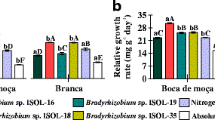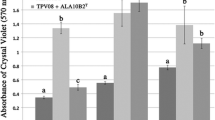Abstract
The effects of Rhizobium strain and its interaction with plant cultivar were examined in glasshouse-grownPhaseolus vulgaris in two experiments where the physiological attributes defining the symbiotic efficiency were determined.
Strains of Rhizobium significantly affected nodulation, rates of N accumulation, partitioning of N within the mature shoot and remobilizaton of the N stored in the vegetative organs to the seeds.
The most efficient symbiosis (strain CO5 with Negro Argel), in comparison with the least efficient symbiosis (strain 127 K-17 with Venezuela-350) showed higher rates of C2H2 reduction from flowering to mid pod fill stage, evolved less hydrogen from nodules and showed higher rates of N transport as well as higher percentages of ureide-N in the xylem sap. At maturity, the best cultivar/strain association exceeded the total N accumulated in the seed and the harvest index of the poorest symbiosis in 88% and 20%, respectively. The other symbiotic combinations were intermediate in all characteristics.
Nitrogen accumulation in plant shoot showed highly significant correlation with acetylene reduction rates, nodule relative efficiency, total N transport in the xylem sap and percentage of N transported as ureides.
Similar content being viewed by others
References
Atkins S L, Herridge D F and Patte J S 1978 The economy of carbon and nitrogen in nitrogen-fixing annual legumes. Isotopes in biological dinitrogen fixation. pp 211–242. FAO/International Atomic Energy Agency, Vienna.
Bedmar E J, Edie S A and Phillips D A 1983. Host plant cultivar effects on hydrogen evolution byRhizobium leguminosarum. Plant Physiol. 72, 1011–1015.
Boddey R M, Pereira J A R, Hungria M, Thomas R J and Neves M C P 1987 Methods for the study of nitrogen assimilation and transport in grain legumes. MIRCEN J. 3, 3–32.
Carter K R, Jennings N T, Hanus J and Evans H J 1978 Hydrogen evolution and uptake by nodules of soybeans inoculated with different strains ofRhizobium japonicum. Can. J. Microbiol. 24, 304–311.
Cookson C, Hughes H and Coombs J 1980 Effects of combined nitrogen on anapleurotic carbon assimilation and bleeding sap composition inPhaseolus vulgaris L. Planta 148, 338–345.
Franco A A and Döbereiner J 1967 Especificidade hospedeira na simbiose com Rhizobium—feijão e influência de diferentes nutrientes. Pesq. Agropec. Bras. 2, 467–474.
Franco A A, Pereira J C and Neyra C A 1979 Seasonal patterns of nitrate reductase and nitrogenase activities inPhaseolus vulgaris L. Plant Physiol. 63, 421–424.
Hardy R W F and Havelka U D 1976 Photosynthate as a major factor limiting nitrogen fixation by field grown legumes with emphasis on soybeans.In Symbiotic Nitrogen Fixation in Plants. Ed. P S Nutman. pp 421–439. Cambridge University Press, Cambridge.
Hardy R W F, Holstein R D, Jackson E K and Burns R C, 1968 The acetylene — ethylene assay for N2 fixation: laboratory and field evaluation. Plant. Physiol. 43, 1185–1207.
Herridge D F, Atkins C A, Pate J S and Rainbird R M 1978 Allantoin and allantoic acid in the nitrogen economy of the cowpea (Vigna unguiculata L. Walp). Plant Physiol. 62, 495–498.
Hungria M and Neves M C P 1986 Efeito da manipulação de fotossintatos na fixação biológica do nitrogênio em feijoeiro. Pesq. agropec. Bras. 21, 9–24.
Hungria M and Neves M C P 1987 Partitioning of nitrogen from biological fixation and fertilizer inPhaseolus vulgaris. Physiol. Plant. 69, 55–63.
Israel D W 1981 Cultivar and Rhizobium strain effects on nitrogen fixation and remobilization by soybeans. Agron. J., 73, 509–516.
Israel D W and McClure P R 1980 Nitrogen translocation in the oxylem of soybeans.In II World Soybean Conference. Ed. F T Corbin. pp. 111–127, Westview Press, Granada.
Lawn R J and Brun W A 1974 Symbiotic nitrogen fixation in soybeans; I—Effect of photosynthetic source-sink manipulation. Crop Sci. 14, 11–16.
Mague T H and Burris R H 1972 Reduction of acetylene and nitrogen by field grown soybeans. New Phytol. 71, 275–286.
Malik N S A 1983 Grafting experiments on the nature of the decline in N2 fixation during fruit development in soybean. Physiol. Plant. 57, 561–564.
McKnight T 1949. Efficiency of isolates of Rhizobium in the cowpea group with proposed additions to this group. Q. J. Agric. Sci. 6, 61–76.
Miller R W and Sirois J C 1982 Relative efficacy of different alfalfa cultivar-Rhizobium meliloti strain combinations for symbiotic nitrogen fixation. Appl. Environm. Microbiol. 43, 764–768.
Minasawa K, Arima Y and Kumazawa K 1983 Transport of fixed nitrogen from soybean nodules inoculated with H2—uptake positive and negativeRhizobium japonicum strains. Soil Sci. Plant Nutr. 29, 85–92.
Minchin F R, Witty J F, Sheehy J E and Muller M 1983 A major error in the acetylene reduction assay: decreases in nodular nitrogenase activity under assay conditions. J. Exp. Bot. 34, 641–649.
Nelson A N and Weaver R W 1980 Seasonal nitrogen accumulation and fixation by soybeans grown at different densities. Agron. J. 72, 613–616.
Neves M C P, Didonet A D, Duque F F and Döbereiner J 1985 Rhizobium strain effects on nitrogen transport and distribution in soybeans. J. Exp. Bot. 36, 1179–1192.
Pacovksky, R S, Bayne H G and Bethlenfalvay G J 1984 Symbiotic interactions between strains ofRhizobium phaseoli and cultivars ofPhaseolus vulgaris L. Crop Sci. 24, 101–105.
Peat J R, Minchin F R, Summerfield R J and Jeffcoat B 1981 Young reproductive structures promote nitrogen fixation in soya bean. Ann. Bot. 48, 177–182.
Rainbird R M, Thorne J H and Hardy R W F 1984 Role of amides, aminoacids and ureides in the nutrition of developing soybean seeds. Plant Physiol. 74, 329–334.
Ruschel A P and Saito S M T 1977 Efeito da inoculação de Rhizobium, nitrogênio e matéria orgânica na fixação de nitrogênio em feijão (Phaseolus vulgaris L.). R. Bras. Ci. Solo 1, 21–24.
Ruschel A P, Saito S M T and Tulman Neto A 1979 Eficiência da inoculação de rhizobium emPhaseolus vulgaris L. I—Efeito de fontes de nitrogênio e cultivares. R. Bras. Ci. Solo 3, 13–17.
Ruschel A P, Vose P B, Matsui E, Victoria R L and Saito S M T 1982 Field evaluation of N2-fixation and nitrogen utilization by Phaseolus bean varieties determined by15N isotope dilution. Plant and Soil 65, 397–407.
Saito S M T, Matsui E and Salati E 198015N2 fixation, H2 evolution and C2H2 reduction relationships inPhaseolus vulgaris. Physiol. Plant. 49, 37–42.
Schubert K R and Evans H J 1976 Hydrogen evolution: a major factor affecting the efficiency of nitrogen fixation in nodulated symbionts. Proc. Nat. Acad. Sci U.S.A. 73, 1207–1211.
Schubert K R and Ryle G J A 1980 The energy requirements for nitrogen fixation in nodulated legumes.In Advances in Legume Science. Eds. R J Summerfield and A H Bunting. pp 85–96. Kew Royal Botanic Gardens, London.
Schubert K R, Jennings N T and Evans H J 1978 Hydrogen reactions of nodulated leguminous plants. Plant Physiol. 61, 398–401.
Streeter J G 1981 Seasonal distribution of carbohydrates in nodules and stem exudate from field-grown soybean plants. Ann. Bot. 48, 441–450.
Thomas R J and Schrader L E 1981a Ureide metabolism in higher plants. Phytochemistry 20, 361–371.
Thomas R J and Schrader L E 1981b, The assimilation of ureides in shoot tissues of soybean. I—Changes in allantoinase activity and ureide contents of leaves and fruits. Plant Physiol. 67, 973–976.
Thomas R J, McFerson J R, Schrader L E and Bliss F A 1984 Composition of bleeding sap nitrogen from lines fo field-grownPhaseolus vulgaris L. Plant and Soil 79, 77–89.
Vincent J M 1970. Manual for the practical Study of Root Nodule Bacteria. IBP. Handbook No. 15 Oxford, Blackwell, 164p.
Author information
Authors and Affiliations
Rights and permissions
About this article
Cite this article
Hungria, M., Neves, M.C.P. Cultivar and Rhizobium strain effect on nitrogen fixation and transport inPhaseolus vulgaris L.. Plant Soil 103, 111–121 (1987). https://doi.org/10.1007/BF02370675
Received:
Revised:
Issue Date:
DOI: https://doi.org/10.1007/BF02370675




